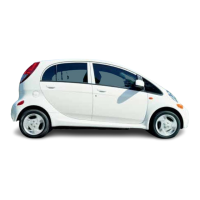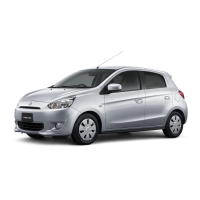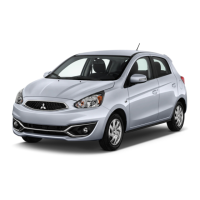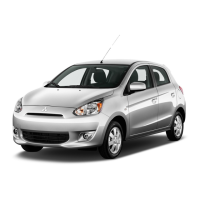2D-22 Chapter 2 Part D General engine overhaul procedures
17.10 Check the ring side clearance 17.11 Measure the piston diameter at a
with a feeler gauge at several points 9lMegree angle to the piston pin and in
around the groove line with it
18.1 The oil holes should be chamfered
so sharp edges don’t gouge or scratch
the new bearings
occur again. The causes may include intake air leaks, incorrect fuel/air
mixture, low octane fuel, ignition timing and EGR system malfunctions.
9 Corrosion of the piston, in the form of small pits, indicates coolant is
leaking into the combustion chamber and/or the crankcase. Again, the
cause must be corrected or the problem may persist in the rebuilt engine.
10 Measure the piston ring side clearance by laying a new piston ring in
each ring groove and slipping a feeler gauge in beside it (see illustration).
Check the clearance at three or four locations around each groove. Se
sure to use the correct ring for each groove-they are different. If the side
clearance is greaterthan specified in this Chapter, new pistons will have to
be used.
11 Checkthe piston-to-bore clearance by measuring the bore (see Sec-
tion 15) and the piston diameter. Make sure the pistons and bores are cor-
rectly matched. Measure the piston across the skirt, at a go-degree angle
to the piston pin (see illustration) below the axis of the piston pin.
12 Subtract the piston diameter from the bore diameter to obtain the
clearance. If it’s greater than listed in this Chapter’s Specifications, the
block will have to be rebored and new pistons and rings installed.
13 Checkthepiston-to-rodclearance by twisting the piston and rod in op-
posite directions. Any noticeable play indicates excessive wear, which
must be corrected. The piston/connecting rod assemblies should be taken
to an automotive machine shop to have the pistons and rods resized and
new pins installed.
14 If the pistons must be removed from the connecting rods for any rea-
son, they should be taken to an automotive machine shop. While they are
there have the connecting rods checked for bend and twist, since automp-
tive machine shops have special equipment for this purpose. Note: Un-
less new pistons and/or connecting rods must be installed, do not
18.2 Use a wire or stiff plastic bristle brush to clean the oil
passages in the crankshaft
disassemble the pistons and connecting rods.
15 Check the connecting rods for cracks and other damage. Temporarily
remove the rod caps, lift out the old bearing inserts, wipe the rod and cap
bearing surfaces clean and inspect them for nicks, gouges and scratches.
After checking the rods, replace the old bearings, slip the caps into place
and tighten the nuts finger tight. Note:
If the engine is being rebuilt be-
cause of a connecting rod knock, be sure to install new rods.
18 Crankshaft - inspection
Refer to illustrations 18.1, 18.2, 18.4, 18.6 and 18.8
1
Remove all burrs from the crankshaft oil holes with a stone, file or
scraper (see illustration).
2 Clean the crankshaft with solvent and dry it with compressed air (if
available). Warnlng:
Weireyeprotection whenusingcompressedair. Be
sure to clean the oil holes with
a
stiff brush
(see illustration)
and flush
them with solvent.
3 Checkthe main and connecting rod bearingjournalsfor uneven wear,
scoring, pits and cracks.
4 Rub a penny across each journal several times (see Illustration). If a
journal picks up copper from the penny, it’s too rough and must be re-
ground.
5 Check the rest of the crankshaft for cracks and other damage. It
should be magnafluxed to reveal hidden cracks-an automotive machine
shop will handle the procedure.
6 Using a micrometer, measure the diameter of the main and connect-
ing rod journals and compare the results to this Chapter’s Specifications
18.4 Rubbing a penny lengthwise on each journal will reveal Its
condition -If copper rubs off and is embedded in the crankshaft,
the journals should be reground

